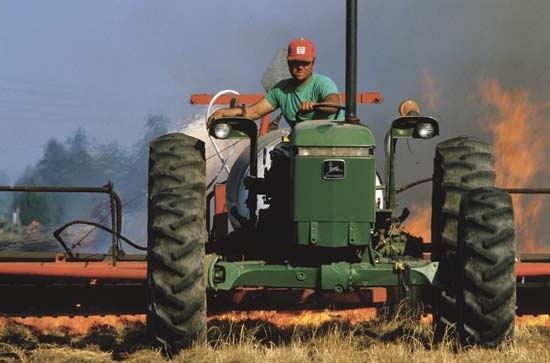slash-and-burn agriculture
agriculture
 method of cultivation often used by tropical-forest root-crop farmers in various parts of the world and by dry-rice cultivators of the forested hill country of Southeast Asia. Areas of the forest are burned and cleared for planting; the ash provides some fertilization, and the plot is relatively free of weeds. After several years of cultivation, fertility declines and weeds increase. Traditionally, the area was left fallow and reverted to a secondary forest of bush. Cultivation would then shift to a new plot; after about a decade the old site could be reused. By the early 21st century, however, cleared areas were typically maintained in a deforested (deforestation) state permanently. Although traditional practices generally created few greenhouse gases, slash-and-burn techniques are a significant source of carbon emissions when used to initiate permanent deforestation. (See also shifting agriculture.)
method of cultivation often used by tropical-forest root-crop farmers in various parts of the world and by dry-rice cultivators of the forested hill country of Southeast Asia. Areas of the forest are burned and cleared for planting; the ash provides some fertilization, and the plot is relatively free of weeds. After several years of cultivation, fertility declines and weeds increase. Traditionally, the area was left fallow and reverted to a secondary forest of bush. Cultivation would then shift to a new plot; after about a decade the old site could be reused. By the early 21st century, however, cleared areas were typically maintained in a deforested (deforestation) state permanently. Although traditional practices generally created few greenhouse gases, slash-and-burn techniques are a significant source of carbon emissions when used to initiate permanent deforestation. (See also shifting agriculture.)- cadmium
- cadmium poisoning
- Cadmus
- Cadmus, Paul
- Cadogan, William Cadogan, 1st Earl
- Cadorna, Luigi
- caduceus
- Cadwallon
- caecilian
- Caecilius of Calacte
- Caecilius, Statius
- Sealyham terrier
- Seaman Asahel Knapp
- Seamans, Robert C., Jr.
- seamount
- sea mouse
- Seamus Heaney
- Sean Fitzpatrick
- Sean F Lemass
- Sean O'Casey
- Sean O'Faolain
- Sean Penn
- Sean T. O'Kelly
- Sea of Azov
- Sea of Crete